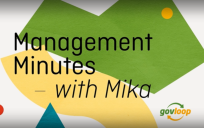I did my first official pitch for a 2.0 project today. There’s not much in it for me, but as a raging populist (/socialist/civil libertarian), I believe in engaging more people in the democratic process. And 2.0 – collaborative government – is a way. … First, I’ve learned that what we must do is go where the people are. Take them the tools. We cannot expect everyone to suddenly adopt Twitter; that’s just not a realistic strategy. However, there are so many community building apps available today, it’s possible to tailor a 2.0 solution or toolbox for just about any set of government problems and level of Web skills. So, here’s my first pitch for a local government, all of which can be implemented at little cost and with little technical know-how:
1) Problem: Increasing the reach and buy-in for emergency readiness programs. Government 2.0 solution: Twitter EMS feed, with periodic manual updates. The handle would encourage users to enable SMS alerts, and would send out periodic tips and news, and supplement traditional sirens and radio emergency broadcasts. Model: @readydotgov Tool: Twitter.com
2) Problem: Desire to engage, but too many e-mails and phone calls for officials to manage effectively. Government 2.0 Solution: A social network for constituents to voice concerns, make suggestions and otherwise interact. Use of real names and zip codes discourages trolls and advances individual buy-in and protection of the community. Users can promote topics of most interest/urgency, and also answer each others’ concerns and questions. Officials step in for harder questions or problems requiring legislative/administrative action. Model: GovLoop.com Tool: Ning.com
3) Problem: Lack of citizen participation in law-making; policies heavily weighted in favor of professional interest groups and lobbyists. Government 2.0 Solution: Open-wiki lawmaking, with the community rewriting and voting on in-progress legisation, and any lobbyist input clearly marked. Example: No Blank Check Letter Tool: MixedInk.com
Thoughts?




Hi Adriel,
I’d be really interested to hear the local government feedback on your proposed 2.0 solutions – as a long-time Local Government ICT evangelist, I’m keen to see them exploit 2.0 tools but I find that it can be hard to build and sustain their courage to relinquish full control of the discussion. I’m especially interested in the EMS idea – does this also include other levels of government, or just local?
We’ll see where it goes – I will definitely post progress here. As far as EMS, here is great information I found (the following is all a paste from the link):
http://www.twitip.com/construct-your-own-top-10-must-follow-list-as-it-relates-to-your-own-niche/
scott zeilenga 11.30.08 at 9:09 am
@scottzeilenga
I operate in the Emergency Management/Disaster Preparedness realm and my top ten list is:
http://twitter.com/Eric_Holdeman
http://twitter.com/carolARC
http://twitter.com/EdIreson
http://twitter.com/kerwood
http://twitter.com/NTARC
http://twitter.com/femainfocus
http://twitter.com/ReadydotGov
http://twitter.com/RedCross
http://twitter.com/wharman
http://twitter.com/nprnews
They don’t all update as frequently as I would like, but when they do you can bet it is pertinent info. (usually)
Adriel:
Looks like you have a lot of ground covered here. A couple of thoughts on the problems you cite: On EMS notification, the use of Twitter could be effective, except for those people who follow scores of other “Tweeters.” A message from EMS could get buried and be three to four “pages” back in a matter of minutes –of course with this member you want to have their tweets sent to your mobile phone as well. Your update suggestion would be critical and EMS could rebroadcast it say every 5 minutes over an hour timeframe.
I like the SMS suggestion as a preferred method. Like they say, 84% of Americans never leave home without it (their phone). Also, The local media would be monitoring these broadcasts as well, I suspect, so there will still be conventional methods to communicate announcements through television and radio.
For using social networks for public engagement, I would like to understand better how it would be used and to solve what challenge. Email for public comment is a waste. Too much to administer, too easy to abuse. Attribution is important. Because if the definition for public comment hasn’t changed in over 225 years, then the challenge is to replicate that on the web, not reinvent it. Think public meeting. Citizen approaches microphone gives, name, address and speaks on point of topic.
Consider replicating three basic forms of engagement that has occurred throughout our democracy: public comment, public discussion/debate, and public choice. Each has a different look and provides a different experience to citizens and to government. Each can be replicated online. Chose the form of engagement you desire or require.
For example, is the purpose to enable citizens to let off steam and if so, we’ll enable anonymous posts, but they will be moderated before being published. Or is it a public comment requirement for a transportation initiative and we need associate socio-demographic criteria to them and generate reports. Do we want to spawn ideas from the public for discussion or do we want to present our own and have them comment and rank them? You get the idea.
I’ve participated in these different online engagement models and they send a powerful message to citizens and government and set expectations about the level of commitment and sincerity to the engagement process as well as how open, transparent and accountable that process will be.
Wow, lots of thoughtful stuff here. A lot of council meetings are comandeered and highly influenced by whackos and special interest groups because they are willing to sacrifice a weeknight to attend the meeting and show up in numbers. Don’t get me wrong; I give them (well, at least the special interest groups) credit in being willing to sacrifice their dinner hour and evening time like I do)
But that said … It would be really valuable if there was a tool that allowed an ‘average citizen’ … swamped with work, swamped with spouse and kids, swamped with other responsibilities .. to speedily and digitally get information about local issues and ‘vote’ by way of thought. The citizen might not be at the council meeting, but a sign of his or her interest and feedback would be there.
Of the many years I’ve spent blogging on local issues as a councilman, by far the highest quality feedback I’ve received has been by way of my SurveyMonkey budget surveys that provide a little nugget of information and then seek feedback or ratings. People like the ease of getting info and the structure by which they can reply.
I definitely like the idea of surveys. Like, why should someone have to go to a meeting to weigh in on their preferred development alternative or (Walter’s example) budget decision?
I’m also strongly in favor of attribution. Many newspapers have the anonymous public comments, and they get loads of foul and valueless content for any controversial story. It it doesn’t address a problem or add value, it’s not worth it.
Many of us may be early adopters, bleeding edgers, cutting edgers, wanna bees participating inside the collective Loop” But, obtaining critical informaiton is important when communicating to target audiences, constituents, stakeholds, clients, employees and team members and our families.
Relative to communications, you must do your research, and from yoru research you must know your target audiences well.. Design, plan and iimplement a phased integrated communication plan spanning across and using multiple channels. Some time the information has to come from “boots” on the ground to get a perspective.
More specific to the EMS realm. Belonging to/being registered with say Alert Montgomery or on one of the local municipalities’ alerting systems gets critical information directly to you via email and cell phone alerts pushed right to you, which is powered by the Roam Secure Alert Network. I am registered with Montgomery County, Fairfax, VA
This (EMS) must also be part of a complete integrated communicaitons plan. as one channel does not fit all, nor serve all. Hence, radio, TV, Internet, Social Groups, Twitter,, fax alerts, foreign language, email and even print newpapers all fit to the integrated plan and final equation.
We are not only spanning a plethera of channels but also generational differences in how audiences “best” consume information, as well as how different ethnic groups, and regions (city, urban, rural and very rural communities) use media/channels/communications.
The following scenarios are real. I straddle a line of being to old to be young and to young to be old. Hence, I have delth with getting critical information to the following sorts of people. There is some great “stuff” out there, it is exciting,and liberating even.
But, that is also why we must not forget to apply integrated communcations strategies. So we can reach others who still consume/ obtain information differently, then most of the rest of us.
My dad, has never ever used the Internet, has no use for it….but he was a slide rule guy way back in day-worked on missles and the development of the first color copiers.
Cell phones, Internet, and twitter, survey monkey are not in his reality.
How do you reach the Cajun French speaking older woman from the WWII era (or a tad later) who are still living in rural Louisiana? These are those who do not speak very much English and do not have any basic information in Cajun French, for an emergency, what to do and who to get help locally.
They are those who have lived here 20-30 years here are Amercian citizens, but still predominantly speak their native tongues, the husband has passed on and the children live across the other side of the United States. I witnessed first hand, that they do not even have access to basic critical EMS information needed, say in French on one sheet of paper. They too do not have Internet, nor twitter, nor a cell phone.
Just a thought or two about the real value of true integrated communication planning.
Twitterworks for many but not everyone,
We must not forget the many who consume information differently,
especially when lives are at stake.
Alice M. Fisher
Hi Adriel – great post. It showed up in my feeds and led me to this network. I left a comment on your other blog, but I’m pretty blogger ate it. 🙁 Very frustrating, because I highlighted some additional examples.
This is really timely, because I’m trying to cast around for a small scale social media project that I can use to help councils in the UK. I’ve posted about my thoughts on what we can do on my blog…
When I was working for the CIO of NOAA Fisheries a few years ago, I worked many times with the office of Constituent Services. We sent out a weekly newsletter to many (can’t recall exact numbers) to both citizens and the press in order to engage with the public on laws and regulations regarding matters related to NOAA Fisheries. It was amazing to see the Government actively engaging with interested parties. In fact, I have been back to NOAA since I left to talk about embracing social media and Enterprise 2.0 practices to make it more transparent they are in fact Government 2.0.
I frequently refer to them when it comes to Government offices who have embraced technology shifts and the evolution the web and interaction with citizens.